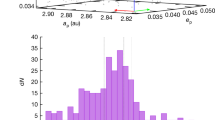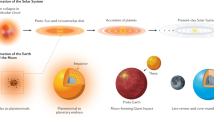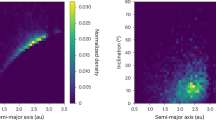Abstract
Fragments of a Perseid meteor, which broke up well above the Earth's atmosphere, probably in collision with a dust particle in near Earth space, have been observed with a two-station low-light level television camera system. Three Perseid meteoroids, with apparent magnitudes between 2.0 and 3.5, arrived on near parallel trajectories within 1.3 s of each other on the morning of 12 August 1977 (03.05.21–03.05.23 UT). The probability of these meteoroids arriving by chance so close together in time and direction is very small (∼3 × 10−11). Assuming the three meteoroids were fragments of a larger body, we show here that the parent meteor must have broken up at least 1,700 km above the Earth's surface, well above the altitude at which meteoroids normally start to burn up in the Earth's upper atmosphere (100–150 km). An estimate of the size of the parent meteor has been made from the observed magnitudes of these fragments. Assuming the parent meteoroid was spinning with an angular velocity between 100 and 1,000 rad s−1, an upper limit to the distance of breakup point from the Earth's surface can be placed at between 7 × 105 and 7 × 106 km (0.004–0.04 AU). We show here that the probabilities of collision and breakup of the parent Perseid with three classes of dust particle in near Earth space—interplanetary, magnetospheric and lunar ejecta—at the time of our observation in 1977, were ∼3 × 10−6, 3 × 10−6 and 5 × 10−7 respectively. We suggest therefore that if the Perseid parent comet (Swift–Tuttle) passes close to the Earth when it returns to perihelion in the next year or two, giving rise to a spectacular display of the Perseids, we should then be able to see many of these associated meteor events, and to study meteor collision with dust particles in near Earth space.
This is a preview of subscription content, access via your institution
Access options
Subscribe to this journal
Receive 51 print issues and online access
$199.00 per year
only $3.90 per issue
Buy this article
- Purchase on SpringerLink
- Instant access to full article PDF
Prices may be subject to local taxes which are calculated during checkout
Similar content being viewed by others
References
Cook, A. F. NASA Contractor Rep. No. 2109, 153–166 (1972).
Lovell, A. C. B. Meteor Astronomy, 131 (Oxford University Press, 1954).
Hughes, D. W. in Cosmic Dust (ed. McDonnell, J. A. M. ) 151 (Wiley, Chichester, 1978).
Hughes, D. W. in Cosmic Dust (ed. McDonnell, J. A. M. ) 164 (Wiley, Chichester, 1978).
Hawkes, R. L. & Jones, J. Mon. Not. Roy. astr. Soc. 185, 727–734 (1978).
Paddack, S. J. & Rhee, J. W. Geophys. Res. Lett. 2, 365–367 (1975).
Southworth, R. B. Smithsonian Contr. Astrophys. 7, 299–303 (1963).
Moore, H. J. & Gault, D. E. U.S. geol. Survey A. Progr. Rep. 127–150 (1965).
Dohnanyi, J. S. J. geophys. Res. 75, 3468–3493 (1970).
Fechtig, H., Grün, E. & Morfill, G. Planet. Space Sci. 27, 511–531 (1979).
Alexander, W. M. & Corbin, J. D. Submicron Lunar Ejecta in the Magnetosphere Associated with Meteor Showers (COSPAR, Budapest, 1980).
Author information
Authors and Affiliations
Rights and permissions
About this article
Cite this article
Hapgood, M., Rothwell, P. Fragmentation of a meteor in near-Earth space. Nature 290, 384–386 (1981). https://doi.org/10.1038/290384a0
Received:
Accepted:
Issue date:
DOI: https://doi.org/10.1038/290384a0
This article is cited by
-
RADAR MEASUREMENTS OF MACRO FRAGMENTATION IN METEOROIDS
Earth, Moon, and Planets (2006)



